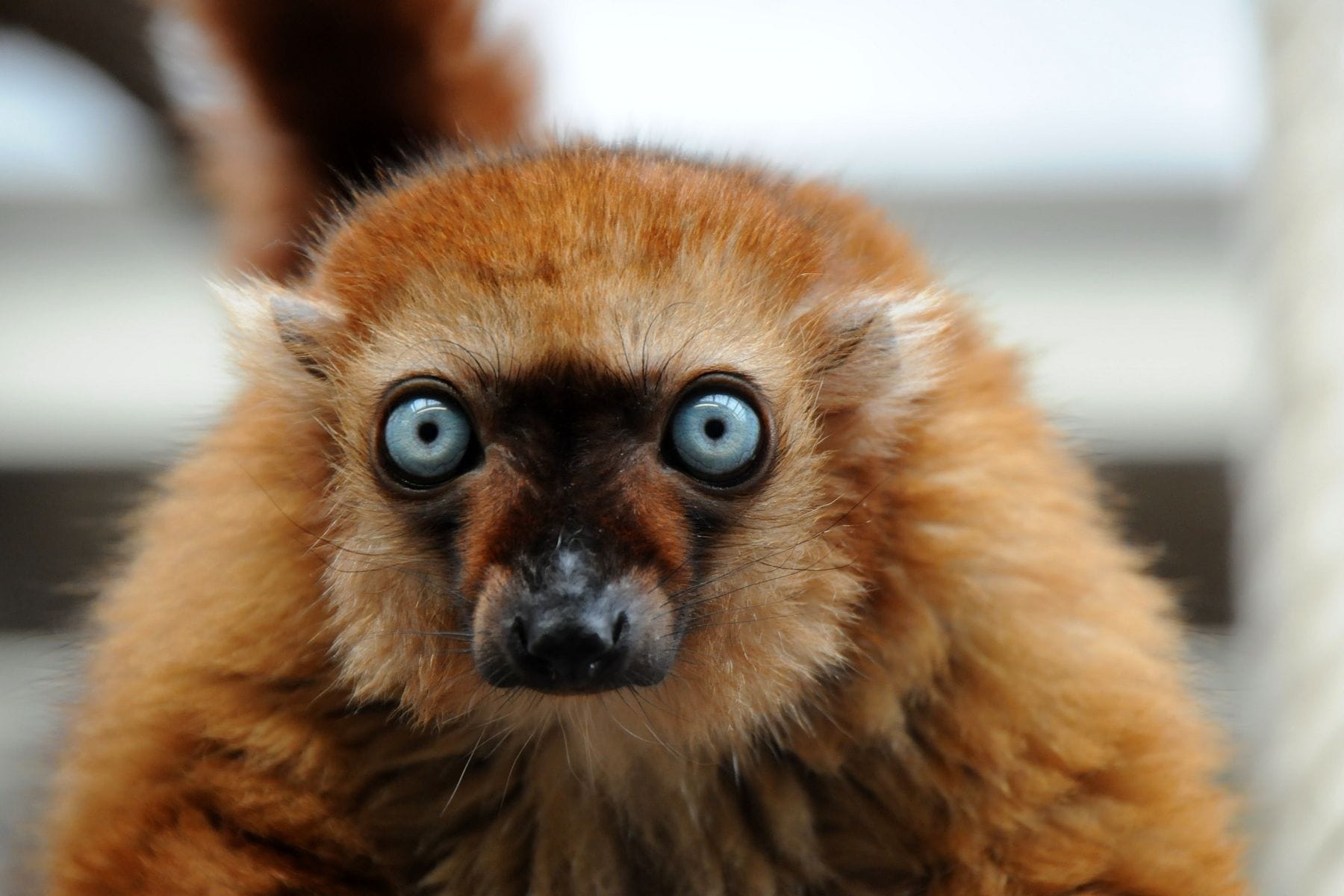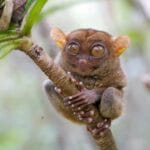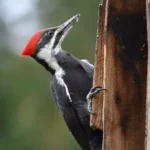The realm of nocturnal primates often conjures up images of tarsiers, those wide-eyed denizens of the forest. But in the heart of Madagascar, another creature shares the spotlight – the aye-aye. Often mistakenly referred to as a “big-eyed lemur,” this fascinating primate is distinctive in its own right, boasting an array of adaptations as unique as its island home.
Unmasking the Aye-aye: A Master of Adaptation
While the phrase “big-eyed lemur” might initially lead to images of tarsiers, a quick trip across the globe to Madagascar will reveal the true holder of that title, the aye-aye (Daubentonia madagascariensis). This nocturnal primate, the largest of its kind, is a testament to the power of evolution, showcasing a suite of physical adaptations that set it apart from all other primates.
One of the aye-aye’s most striking features is its large, round eyes, each resembling a silver dollar glued to its face. Unlike the fixed gaze of the tarsier, the aye-aye’s eyes move independently, allowing for exceptional scanning and depth perception in the low-light conditions of its rainforest habitat. This remarkable adaptation, paired with exceptionally large, sensitive ears, makes the aye-aye a master of navigating the darkness and locating its favorite prey – wood-boring grubs.
But the adaptations don’t stop there. The aye-aye possesses continuously growing incisors, reminiscent of a rodent, which it uses to gnaw through bark and wood, exposing hidden insect tunnels. Once a grub is detected, a truly bizarre adaptation comes into play – the aye-aye’s extraordinarily long, thin middle finger. This skeletal finger, a marvel of natural engineering, is used to tap on wood, listening for the telltale echo of hollow cavities within. Once located, the aye-aye uses this same finger to deftly extract the grub, demonstrating a feeding strategy known as “percussive foraging” that is unique in the primate world.
Living on the Edge: Habitat, Conservation, and a Fragile Future
The aye-aye’s entire existence is intertwined with the dwindling rainforests of Madagascar. These forests, facing increasing pressure from human activities, are not only the source of the aye-aye’s food and shelter, but also play a crucial role in the species’ survival. The aye-aye’s nocturnal lifestyle offers some protection from predators, but it does little to shield it from the most significant threat it faces – habitat loss.
Deforestation, driven by agriculture, logging, and mining, continues to fragment the aye-aye’s rainforest home, pushing this unique primate towards increasingly smaller and more isolated pockets. Adding to the challenge is the pervasive threat of hunting. Steeped in local folklore and superstition, the aye-aye is often perceived as a harbinger of ill omen, leading to persecution and killing.
Recognizing the plight of the aye-aye, the International Union for Conservation of Nature (IUCN) has classified the species as Endangered. Thankfully, conservation efforts are underway to protect this evolutionary marvel. National parks and reserves have been established across Madagascar, providing a safe haven for the aye-aye and other endemic species.
Furthermore, research and monitoring programs are working tirelessly to understand the aye-aye’s ecology and behavior, providing crucial data to inform effective conservation strategies. Community outreach and education programs are also essential, aiming to dispel myths and foster a sense of appreciation and understanding for the aye-aye’s vital role in the delicate balance of Madagascar’s ecosystems.
Beyond the Big Eyes: A Unique Branch on the Primate Tree
It’s easy to see why the aye-aye, with its large eyes and nocturnal habits, is often lumped together with tarsiers in the minds of many. However, these two captivating creatures, while sharing some superficial similarities, occupy distinct branches on the primate evolutionary tree.
Here’s a closer look at the key differences:
| Feature | Aye-aye | Tarsier |
|---|---|---|
| Classification | Lemur | Tarsier (separate primate family) |
| Size | Larger (body length around 16 inches) | Smaller (body length around 3-6 inches) |
| Tail | Long, bushy, prehensile (can grasp) | Long, slender, not prehensile |
| Middle Finger | Extremely long and thin | Short |
| Activity | Strictly nocturnal | Active at dusk and dawn (crepuscular) |
The aye-aye’s unique combination of characteristics, from its large, independently moving eyes and rodent-like teeth to its uncanny middle finger and specialized feeding strategy, highlights the remarkable diversity within the primate order.
By understanding and appreciating the differences between the aye-aye and other similar-looking species, we can better grasp the intricate web of life that connects all living things. Furthermore, this knowledge empowers us to become more effective advocates for conservation, ensuring that future generations will have the opportunity to marvel at the extraordinary adaptations of the aye-aye, a true testament to the wonders of evolution.
What is the name of the lemur with big eyes?
When it comes to lemurs with striking eyes, the aye-aye reigns supreme. Often mistaken for a tarsier due to its large, round peepers, the aye-aye is a testament to the unique biodiversity found in Madagascar, distinguishing itself as the world’s largest nocturnal primate. Its eyes, resembling gleaming silver dollars, are not merely decorative; they are evolutionary marvels, granting exceptional night vision in the shadowy depths of its rainforest home.
Unlike tarsiers, whose eyes are fixed in their sockets, the aye-aye possesses the remarkable ability to move its eyes independently, allowing for enhanced scanning and depth perception in low-light conditions. This, coupled with its large, bat-like ears, makes the aye-aye a master of navigating its nocturnal world. But the eyes are just the beginning of the aye-aye’s oddities. It boasts continuously growing, rodent-like teeth, perfect for gnawing through wood and exposing its favorite prey – wood-boring grubs.
And let’s not forget that extraordinary middle finger—elongated, skeletal, and possessing an almost otherworldly appearance. This multi-purpose tool is used for tapping on trees, listening for the telltale echo of hollow spaces harboring grubs, and then extracting them with surgical precision.
The aye-aye’s large eyes, often the first thing that captures our attention, are symbolic of the species’ overall uniqueness. They represent a suite of adaptations that make this lemur a true marvel of the natural world.
What is the name of the Giant Lemur?
The term “giant lemur” evokes images of massive primates dominating the canopy, but the reality is a bit more nuanced. While no single species today holds the title of “giant lemur,” Madagascar, the lemur’s evolutionary cradle, is home to some impressively large species, both past and present.
The Indri (Indri indri), a striking lemur with a haunting call that echoes through the rainforest, holds the title of the largest living lemur, reaching heights of up to three feet. However, when it comes to size relative to other lemurs, the aye-aye, with its large eyes and nocturnal habits, often earns the colloquial, albeit inaccurate, title of “giant lemur.”
Historically, Madagascar was home to a diverse group of primates known as “giant lemurs.” These remarkable creatures, some as large as gorillas, roamed the island for millions of years, filling a variety of ecological niches. Sadly, they vanished around 1,000 years ago, likely due to a complex interplay of human activities, such as hunting and deforestation, and environmental shifts.
While the giant lemurs of the past are gone, their legacy underscores the incredible biodiversity that once existed on Madagascar and the fragility of island ecosystems. Today, the aye-aye, the Indri, and the numerous other lemur species that grace Madagascar’s forests serve as a reminder of the need for conservation, ensuring that these unique primates continue to thrive for generations to come.
Why did giant lemurs go extinct?
The extinction of giant lemurs, a diverse group of primates that once thrived in Madagascar, remains a subject of ongoing scientific inquiry. While a definitive answer eludes us, evidence suggests a complex interplay of factors likely contributed to their demise.
The arrival of humans on Madagascar, approximately 2,000 years ago, marked a turning point for the island’s fauna. Hunting pressure on these large, slow-moving lemurs, combined with deforestation for agriculture and settlements, placed immense pressure on their populations.
Concurrently, Madagascar experienced a period of significant climate change, with increasing aridity transforming the landscape. This environmental shift likely disrupted the giant lemurs’ food sources, further compounding the challenges they faced.
Some scientists theorize that giant lemurs played a critical role in seed dispersal within Madagascar’s ecosystems. Their extinction may have disrupted these ecological processes, impacting forest regeneration and overall ecosystem health, creating a cascade of negative effects.
The disappearance of giant lemurs serves as a stark reminder of the fragility of island ecosystems, particularly in the face of human impacts. While we cannot rewrite history, understanding the factors that led to their extinction can inform our conservation efforts today. By studying past extinctions, we gain valuable insights into the complex interplay of environmental change, human activities, and species vulnerability, allowing us to develop more effective strategies to protect endangered species and preserve biodiversity.
The camel species, the bactrian pair, is one of the most endangered in the world, with around 1,000 individuals remaining in the wild. You might also be interested in the Brazilian blue tarantula, the largest tarantula species in the world, which can grow up to 12 inches in body length.
















